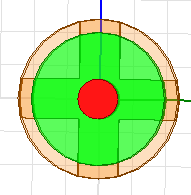DeboraHarry
Full Member level 5
I'm trying to model an antenna which is a bit like leaky feeder, though the aim is to make a vertical colinear, rather than the usual use of leaky feeder.
I want to create a coax from a copper tube (outer conductor) and brass rod (inner conductor). The idea is that the braid will have a number of slots, through which radiation will escape. In the diagram below, there are 4 slots, but I'd like to have 8 or more, so the radiation pattern is as omnidirectional as reasonably practical.

Here's an end-on view

The plan would be to repeat this vertically, so a second group of 4 or 8 slots is placed some distance above the first lot.
I've defined a box and used that to cut out the slots, but are not sure how best to cut the slots out, in a way which gives me the most flexibility. Ideally I'd like to be able to change the number of slots and their positions along the coax by use of parameters. I would like to avoid being in the situation where the slots are cut, but I can't change anything easily.
In one attempt, i have a single slot and have united this with the vacuum of the airbox. But I get an error message
[error] ACIS entity check failed for part: SlotCutInCopperTube
[info] Use Modeler/Validation Settings to relax ACIS entity checking or Modeler/Model Analysis/Heal to fix check errors.
Can anyone suggest the best way to make the cuts in the coax, such that I maintain maximum flexibility? Should I unite the AirBox with the box used to create the slots? Obviously once the slots are cut in the braid and dielectric, the inner conductor will meet the airbox.
I don't know if this makes any sence.
Deborah
I want to create a coax from a copper tube (outer conductor) and brass rod (inner conductor). The idea is that the braid will have a number of slots, through which radiation will escape. In the diagram below, there are 4 slots, but I'd like to have 8 or more, so the radiation pattern is as omnidirectional as reasonably practical.

Here's an end-on view

The plan would be to repeat this vertically, so a second group of 4 or 8 slots is placed some distance above the first lot.
I've defined a box and used that to cut out the slots, but are not sure how best to cut the slots out, in a way which gives me the most flexibility. Ideally I'd like to be able to change the number of slots and their positions along the coax by use of parameters. I would like to avoid being in the situation where the slots are cut, but I can't change anything easily.
In one attempt, i have a single slot and have united this with the vacuum of the airbox. But I get an error message
[error] ACIS entity check failed for part: SlotCutInCopperTube
[info] Use Modeler/Validation Settings to relax ACIS entity checking or Modeler/Model Analysis/Heal to fix check errors.
Can anyone suggest the best way to make the cuts in the coax, such that I maintain maximum flexibility? Should I unite the AirBox with the box used to create the slots? Obviously once the slots are cut in the braid and dielectric, the inner conductor will meet the airbox.
I don't know if this makes any sence.
Deborah